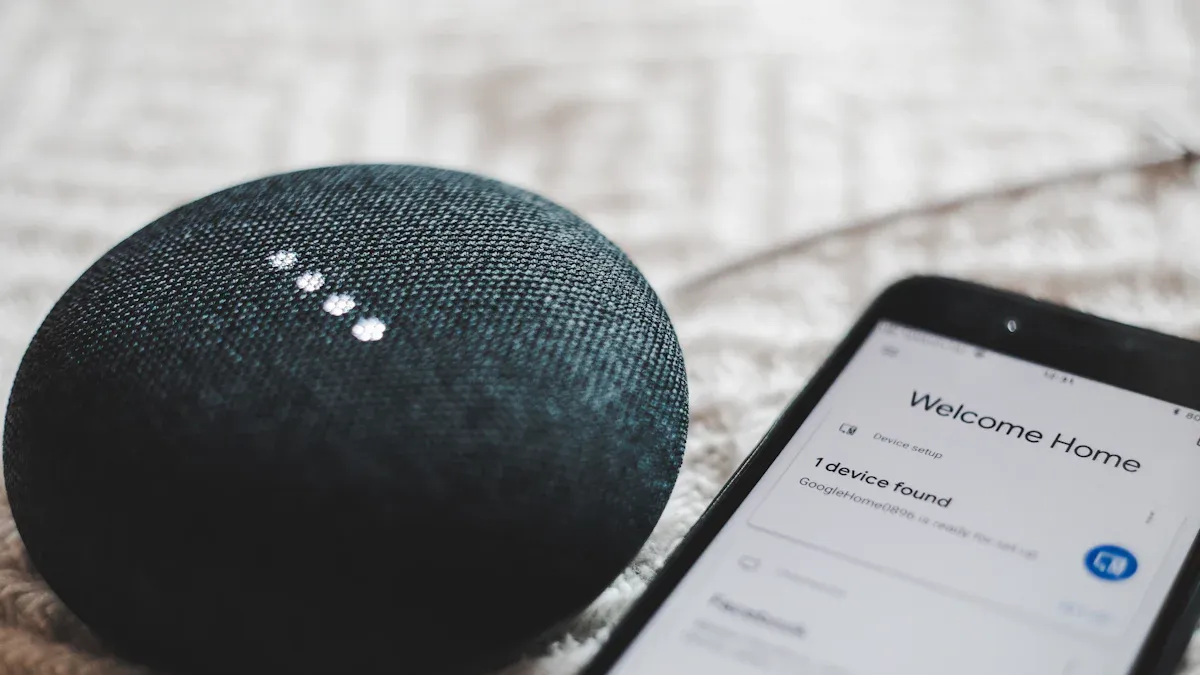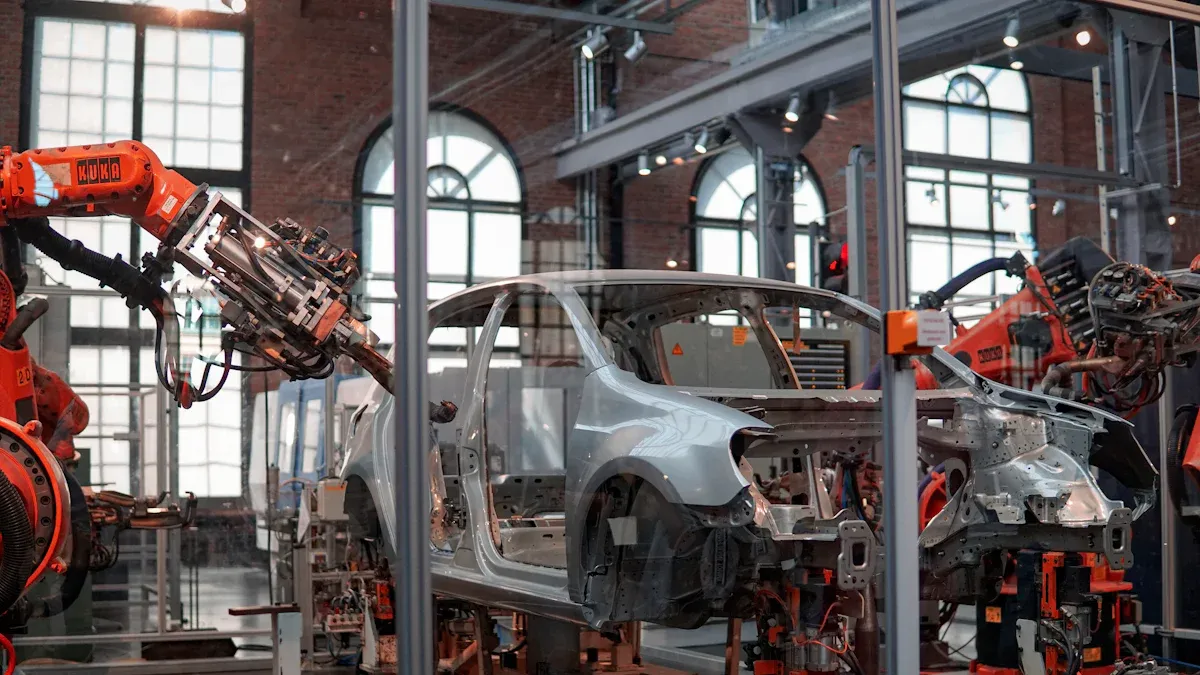Image Source: unsplash
By 2025, IoT Trends 2025: Smart Devices Transforming Industries will revolutionize various sectors, making systems smarter than ever. Businesses will leverage IoT to uncover significant opportunities. Over 30.9 billion devices are expected to connect by 2025, driving growth in healthcare, factories, and smart cities. Ignoring these IoT trends means risking obsolescence. IoT is not just a trend—it’s the future.
Key Takeaways
- IoT will link over 30.9 billion devices by 2025. It will change industries like healthcare, factories, and smart cities.
- 5G lets devices talk instantly, making IoT quicker and better.
- AI and edge computing help IoT by giving instant insights. They cut delays and improve decision-making.
Advancements in Connectivity Technologies
5G Changing How IoT Works
5G is a big deal for IoT. It’s super fast and has almost no delay. Devices can talk to each other instantly. Picture a factory where machines share data quickly to work better. Or think of a self-driving car reacting to the road in a split second. That’s what 5G can do. It helps devices handle lots of data without slowing down. This is very important for healthcare and smart cities. To stay ahead, using 5G with IoT is a must.
LPWAN for Bigger IoT Networks
Low Power Wide Area Networks (LPWAN) are great for connecting many devices over large spaces. LPWAN helps industries by covering long distances and saving energy. For example, it’s useful for checking oil fields far away or running smart farms. Here’s why LPWAN is helpful:
| Benefit | What It Does |
|---|---|
| Long-range coverage | Connects sensors and devices far apart in big areas. |
| Low power consumption | Saves battery life, which is good for hard-to-reach places. |
| Scalability solutions | Handles more devices without slowing down. |
| Cost-effectiveness | Keeps costs low for setting up and running systems. |
If you need a network that’s big and affordable, LPWAN is the answer.
Making Devices Work Together Better
Getting devices to work together is key for IoT. Without it, devices from different brands can’t talk to each other. Standards like Matter help fix this by making sure devices connect easily. This stops problems and helps new ideas grow. For example, smart home gadgets now work better together, giving users a smoother experience.
Here are some important standards helping IoT grow:
| Standard | What It Does |
|---|---|
| 6LoWPAN | Lets low-power devices connect to the internet. |
| MQTT | Helps devices send messages easily. |
| CoAP | Works well in small spaces, like a simpler version of HTTP. |
| Zigbee/Z-Wave | Wireless systems for smart home gadgets. |
| OPC UA | Keeps industrial devices talking securely. |
With edge computing and AI growing, new rules are needed for faster communication and smarter decisions. Focus on making devices work together to get the most out of IoT.
AI and Edge Computing in IoT
Real-Time Insights with AI Integration
AI helps IoT by giving quick and smart insights. It studies data from sensors to find patterns and problems. This helps businesses fix issues before they get worse. For example, AI checks machines and warns teams about possible breakdowns. These warnings save time and money by fixing things early. AI also uses past data to guess future events. This helps businesses prepare for challenges ahead. Knowing what might happen next is a big advantage. AI makes IoT systems smarter and more useful.
Edge Computing for Low-Latency Data Processing
Edge computing makes IoT faster by handling data nearby. It avoids delays from sending data to faraway servers. This means quicker actions and better results. Businesses use it for fast decisions, like in self-driving cars or factory machines. It also keeps data safer by storing it locally. Sharing tasks between devices improves speed and saves energy. With edge computing, IoT becomes quicker, safer, and more dependable. It’s important for staying ahead in today’s fast world.
Autonomous IoT Systems in Action
Autonomous IoT systems are already working today. Self-driving cars use sensors to move and decide instantly. Smart grids predict energy needs and manage power without help. Drones process videos to avoid crashes and change paths quickly. In factories, sensors adjust machines for better performance. Smart cities use sensors to control traffic and keep people safe. These systems show how IoT and AI solve daily problems in smart ways.
IoT Trends 2025: Smart Devices Supporting Sustainability
Saving Energy with Smart IoT Tools
Saving energy is now very important. IoT tools help industries use less energy and save money. These tools show how much energy is used in real-time. This helps businesses make better choices. Predictive maintenance is also very helpful. It watches machines to stop problems before they happen. This keeps machines working well and avoids costly repairs. The predictive maintenance market is growing fast, from $1.42 billion in 2023 to $4.47 billion by 2028. IoT also helps people track and lower their energy use. These tools save money and help build a greener future.
Smarter Waste Management with IoT
IoT is changing how we handle waste. Smart trash bins have sensors that check when they are full. This helps trucks take the best routes, saving fuel and keeping cities clean. AI systems can sort trash automatically, making recycling easier. Remote tools watch over waste sites to keep them safe. Data from IoT helps leaders improve waste systems. These ideas make waste management cleaner, smarter, and better for the planet.
Protecting Nature with IoT
IoT helps us care for the Earth. Sensors track energy use and help cut waste. Farmers use IoT to water crops better, saving water and growing more food. IoT fire alarms warn about forest fires early. Flood systems study rain and soil to warn about floods. These tools help keep the planet safe and green for everyone.
Industry-Specific IoT Applications

Image Source: unsplash
Healthcare: Changing How Patients Get Care
IoT is making healthcare better and easier. Wearable devices now check important health signs all the time. This helps doctors watch patients without needing them to visit. Hospitals use IoT to manage beds and find equipment faster. Telemedicine lets patients talk to doctors from home, saving time. Smart pill dispensers remind people to take their medicine and track if they do. These tools make healthcare simpler and more helpful.
-
Key IoT Applications in Healthcare:
- Wearables for checking patients remotely.
- Telemedicine for doctor visits from home.
- Smart hospitals for better equipment use.
- Pill reminders for taking medicine on time.
Manufacturing: Making Factories Smarter
IoT has improved how factories work. Machines now warn about problems before breaking down. This saves money and time. Sensors track products as they move through factories. They also check the air and temperature to keep things safe. Smart tools check products during making to avoid mistakes. These changes make factories faster and more dependable.
-
Key IoT Applications in Manufacturing:
- Fixing machines before they break.
- Tracking items in the factory.
- Checking product quality with sensors.
- Managing factory conditions better.
Smart Cities: Creating Better Places to Live
IoT helps cities become smarter and safer. Cameras and sensors make emergency help quicker. Smart streetlights save energy and make roads safer. People can share ideas with city leaders using IoT apps. Traffic systems use IoT to plan better routes and reduce jams. These tools make cities cleaner, safer, and easier to live in.
-
Key IoT Applications in Smart Cities:
- Cameras for public safety.
- Traffic systems for smoother travel.
- Energy-saving streetlights.
- Apps for sharing ideas with leaders.
Retail: Improving Shopping Experiences
IoT is changing how we shop. Smart screens suggest items based on what you like. Sensors know where you are in the store and give tips. IoT also helps stores learn what you buy and suggest matching items. These changes make shopping more fun and personal.
-
Key IoT Applications in Retail:
- Smart screens for product suggestions.
- Sensors for location-based tips.
- Data to suggest matching products.
Overcoming IoT Challenges in 2025
Fixing IoT Security Problems
IoT security is a big issue today. Ignoring it can hurt businesses. Old software and unprotected devices cause many problems. Did you know 60% of IoT hacks happen because of this? Botnets now cause 35% of all DDoS attacks. These attacks stop systems and waste time. Protecting IoT devices is very important.
Here are the main risks:
| Risk Type | Example |
|---|---|
| Device Problems | 60% of IoT hacks come from old software and firmware. |
| Botnets & DDoS Attacks | Botnets cause 35% of all DDoS attacks. |
| Data Privacy Issues | Over 25% of IoT hacks involve stolen personal data. |
| Industrial IoT (IIoT) Threats | Cyberattacks on industrial IoT grew by 75% in two years. |
To stay safe, update software often. Use strong passwords and two-step verification. These steps protect your business from hacks and damage.
Following New IoT Rules
IoT rules are changing fast. Keeping up is very important. Many businesses struggle with rules about labels and records. For example, the IoT Cybersecurity Improvement Act of 2020 requires NIST standards for federal IoT devices. Canada’s PIPEDA law also asks for safe handling of personal data.
Steps to follow include:
- Keeping records like Declaration of Conformity (DoC).
- Adding clear labels for tracking products.
- Using NIST standards for federal IoT devices.
Following these rules helps businesses run smoothly and gain customer trust.
Solving Growth and Connection Problems
Growing IoT systems can be hard, but there are solutions. Modular systems let you expand step by step without big costs. Cloud storage helps keep data safe and easy to access.
TiDB’s multi-region system is very helpful. It spreads data across places, making it faster and more reliable. Central platforms also make connecting devices easier and save time.
Using these ideas, you can grow IoT systems safely and keep them working well.
IoT is changing how things work and making them better. With machine learning, devices handle huge amounts of data quickly. This helps them work on their own and make smart guesses, saving time. For example, BMW uses sensors to predict machine problems early. In Barcelona, IoT helps change traffic routes during emergencies. These examples show how powerful IoT can be.
To keep up, businesses need to use IoT wisely. They should focus on being eco-friendly, growing easily, and staying safe. Connected devices can give useful information, improve customer service, and lower risks. IoT isn’t just a tool—it’s a big deal. Let’s use it to build a smarter and more connected world.
FAQ
Which industries gain the most from IoT in 2025?
IoT helps industries like healthcare, factories, and stores. It makes work faster, saves money, and improves customer service. Any business can benefit by using IoT.
How do businesses keep IoT systems secure?
Update software often and use strong passwords. Add two-step verification for extra safety. These actions protect your IoT devices from hackers.
Tip: Use special security tools for IoT to protect data and devices.
Is using IoT too costly for small businesses?
Not always! Affordable options like LPWAN and cloud systems help. Start with a small setup and grow as needed. It’s a smart way to plan for the future.
